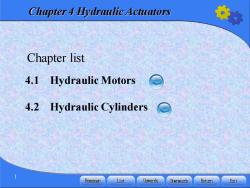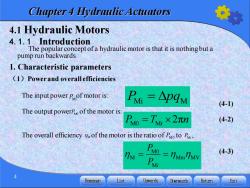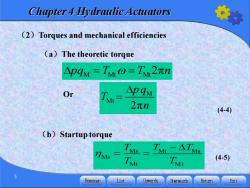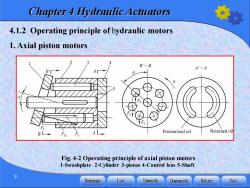福州大学:《液压与气压传动》课程电子教案(PPT教学课件)Chapter 04 Hydraulic Actuators

Chapter 4 Hydraulic Actuators Chapter list 4.1 Hydraulic Motors 4.2 Hydraulic Cylinders Homepage List Upwards Dowrwards Retun Exit
Chapter 4 Hydraulic Actuators 1 4.1 Hydraulic Motors 4.2 Hydraulic Cylinders Chapter list

Chapter 4 Hydraulic Actuators The function of hydraulic actuators is to translate hydraulic energy of fluid into energy of the machine.They will drive the mechanism motion path like a straight,swing or rotation.The straight or swing are referred as hydraulic actuator or swing motion actuator,and the rotational motion is called hydraulic motor.The output parameters are force and speed or torque and rotating speed. Homepage List Upwards Downwards Retum Exit
Chapter 4 Hydraulic Actuators 2 The function of hydraulic actuators is to translate hydraulic energy of fluid into energy of the machine. They will drive the mechanism motion path like a straight, swing or rotation. The straight or swing are referred as hydraulic actuator or swing motion actuator, and the rotational motion is called hydraulic motor. The output parameters are force and speed or torque and rotating speed

Chapter 4 Hydraulic Actuators 4.1 Hydraulic Motors 4.1.1 Introduction 4.1.2 Operating principle of hydraulic motors 4.1.3 Low-speed motors 3 Homepage List Upwards Dowrwards Retun Exit
Chapter 4 Hydraulic Actuators 3 4.1 Hydraulic Motors 4.1.1 Introduction 4.1.2 Operating principle of hydraulic motors 4.1.3 Low-speed motors

Chapter 4 Hydraulic Actuators 4.1 Hydraulic Motors 4.1.1 Introduction The popular concept of a hydraulic motor is that it is nothing but a pump run backwards. 1.Characteristic parameters (1)Power and overall efficiencies The input power P of motor is: PMi =ApqM (4-1) The output powerP of the motor is: Ro=Tw×2n (4-2) The overall efficiency nof the motor is the ratio of PMo to P, 1M= (4-3) M 2=1门MmlN Homepage List Upwards Downward止 Return Exit
Chapter 4 Hydraulic Actuators 4 4.1 Hydraulic Motors 4.1.1 Introduction The popular concept of a hydraulic motor is that it is nothing but a pump run backwards. 1. Characteristic parameters (1)Power and overall efficiencies The input power of motor is: (4-1) The output power of the motor is: (4-2) The overall efficiency of the motor is the ratio of to , (4-3) P pq Mi M = M0 M 2π P T n = t M0 M Mm MV Mi P P = = PMi PM0 M PM0 PMi

Chapter 4 Hydraulic Actuators (2)Torques and mechanical efficiencies (a)The theoretic torque pqM=TMmo=TM2πn Or △pqM 2元n (4-4) (b)Startup torque TM-△TMs TMt TMt (4-5) 5 Homepage List Upwards Dowrwards Return Exit
Chapter 4 Hydraulic Actuators 5 (2)Torques and mechanical efficiencies (a)The theoretic torque Or (b)Startup torque M Mt Mt = = pq T T n 2π M Mt 2π p q T n = Ms Mt Ms Ms Mt Mt T T T T T − = = (4-4) (4-5)

Chapter 4 Hydraulic Actuators (c)Mechanical efficiencies thus TMo =TMt -ATMo (4-6) Mm1 TMo.IM ATMo TMt TMt (4-7) (3)Flow rate and volumetric efficiency 9M=9Mt+△q (4-8) 6 Homepage List Upwards Downward止 Return Exit
Chapter 4 Hydraulic Actuators 6 (c) Mechanical efficiencies thus (4-6) (4-7) T T T Mo Mt Mo = − Mo Mt Mo M m Mt Mt T T T T T − = = (3)Flow rate and volumetric efficiency q q q M Mt = + (4-8)

Chapter 4 Hydraulic Actuators 7ww-M=9M广A9=I- △q gM 9M 9M (4-9) (4)Delivery and rotating speed n= 9ML9MTMY (4-10) V (5)Working and rated pressures Homepage List Upwards Dowrwards Retun Exit
Chapter 4 Hydraulic Actuators 7 (4-9) (4)Delivery and rotating speed (4-10) (5)Working and rated pressures Mt M MV M M M 1 q q q q q q q − = = = − Mt M MV q q n V V = =

Chapter 4 Hydraulic Actuators 2.classification Motors may be classified based upon their working performances: (1)High-speed hydraulic motors whose rated rotating speed is beyond 500r/min; (2)Low-speed hydraulic motors whose rated rotatingspeed is below 500r/min. High-speed hydraulic motors may be further divided into gear motors,vane motors,axial piston motors,screw motors,etc.Low-speed hydraulic motors include single-acting connectingrod type radial piston motors and incurve multiple-acting radial piston motors. Motors can also be classified as fixed delivery and variable delivery according to their delivery types. The graphic symbols of motor is shown in Fig.4-1. b Fig.4-1 Graphics symbols of motor a)Fixed delivery motor b)Variable delivery motor 8 Homepage List Upwards Downward止s Retumn Exit
Chapter 4 Hydraulic Actuators 8 2. classification Motors may be classified based upon their working performances: (1) High-speed hydraulic motors whose rated rotating speed is beyond 500r/min; (2) Low-speed hydraulic motors whose rated rotating speed is below 500r/min. High-speed hydraulic motors may be further divided into gear motors, vane motors, axial piston motors, screw motors, etc. Low-speed hydraulic motors include single-acting connecting rod type radial piston motors and incurve multiple-acting radial piston motors. Motors can also be classified as fixed delivery and variable delivery according to their delivery types. Fig.4-1 Graphics symbols of motor a) Fixed delivery motor b) Variable delivery motor The graphic symbols of motor is shown in Fig.4-1

Chapter 4 Hydraulic Actuators 4.1.2 Operating principle of hydraulic motors 1.Axial piston motors B—B A一 Pressurized oil Returned oi Fig.4-2 Operating principle of axial piston motors 1-Swashplate 2-Cylinder 3-piston 4-Control lens 5-Shaft Homepage List Upwards Dowrwards Return Exit
Chapter 4 Hydraulic Actuators 9 4.1.2 Operating principle of hydraulic motors 1. Axial piston motors Fig. 4-2 Operating principle of axial piston motors 1-Swashplate 2-Cylinder 3-piston 4-Control lens 5-Shaft

Chapter 4 Hydraulic Actuators 2.Vane motors Double-acting vane motors are generally used in industrial hydraulic systems,here a double-acting design operation is illustrated as follows: Fig.4-3 Operating principle of balanced vane motor Pla D吧 1,2,3,4,5,6,7,8-Vanes 10 Homepage List Upwards Downward止 Retumn Exit
Chapter 4 Hydraulic Actuators 10 2. Vane motors Double-acting vane motors are generally used in industrial hydraulic systems, here a double-acting design operation is illustrated as follows: Fig.4-3 Operating principle of balanced vane motor 1, 2 , 3 , 4 , 5 , 6 , 7 , 8-Vanes
按次数下载不扣除下载券;
注册用户24小时内重复下载只扣除一次;
顺序:VIP每日次数-->可用次数-->下载券;
- 福州大学:《液压与气压传动》课程电子教案(PPT教学课件)Chapter 03 Hydraulic Pumps.pptx
- 福州大学:《液压与气压传动》课程电子教案(PPT教学课件)Chapter 02 Fundamental Hydraulic Fluid Mechanics.pptx
- 福州大学:《液压与气压传动》课程电子教案(PPT教学课件)Chapter 01 Introduction to Hydraulic and Pneumatic Transmission.pptx
- 福州大学:《液压与气压传动》课程电子教案(PPT教学课件)第12章 气动传动系统实例.pptx
- 福州大学:《液压与气压传动》课程电子教案(PPT教学课件)第11章 气动基本回路及其应用.pptx
- 福州大学:《液压与气压传动》课程电子教案(PPT教学课件)第10章 气源装置及气动元件.pptx
- 福州大学:《液压与气压传动》课程电子教案(PPT教学课件)第9章 液压系统的设计计算.pptx
- 福州大学:《液压与气压传动》课程电子教案(PPT教学课件)第8章 典型液压系统.pptx
- 福州大学:《液压与气压传动》课程电子教案(PPT教学课件)第7章 液压基本回路.pptx
- 福州大学:《液压与气压传动》课程电子教案(PPT教学课件)第6章 液压辅件.pptx
- 福州大学:《液压与气压传动》课程电子教案(PPT教学课件)第5章 液压控制阀.pptx
- 福州大学:《液压与气压传动》课程电子教案(PPT教学课件)第4章 液压马达与液压缸.pptx
- 福州大学:《液压与气压传动》课程电子教案(PPT教学课件)第3章 液压泵.pptx
- 福州大学:《液压与气压传动》课程电子教案(PPT教学课件)第2章 液压流体力学基础.pptx
- 福州大学:《液压与气压传动》课程电子教案(PPT教学课件)第1章 液压与气压传动概论.pptx
- 福州大学:《液压与气压传动》课程授课教案 Hydraulic and Pneumatic Transmission(英文讲义,负责人:陈淑梅).pdf
- 福州大学:《液压与气压传动》课程试卷及参考答案(英文).pdf
- 福州大学:《液压与气压传动》课程作业习题(英文,无答案).pdf
- 福州大学:《液压与气压传动》课程实验指导书(英汉双语)液压与气压传动实验指导书 Hydraulic and Pneumatic Transmission Instructor of Experimental Projects.pdf
- 福州大学:《液压与气压传动》课程教学大纲 Hydraulic and Pneumatic Transmission.pdf
- 福州大学:《液压与气压传动》课程电子教案(PPT教学课件)Chapter 05 Hydraulic Control Valves.pptx
- 福州大学:《液压与气压传动》课程电子教案(PPT教学课件)Chapter 06 Auxiliary Components for Hydraulic Systems.pptx
- 福州大学:《液压与气压传动》课程电子教案(PPT教学课件)Chapter 07 Basic Hydraulic Circuits.pptx
- 福州大学:《液压与气压传动》课程电子教案(PPT教学课件)Chapter 08 Examples of Hydraulic Systems.pptx
- 福州大学:《液压与气压传动》课程电子教案(PPT教学课件)Chapter 09 Design of Hydraulic Transmission systems.pptx
- 福州大学:《液压与气压传动》课程电子教案(PPT教学课件)Chapter 10 Air Supply Devices and Pneumatic Components.pptx
- 福州大学:《液压与气压传动》课程电子教案(PPT教学课件)Chapter 11 Basic Circuits and their Application.pptx
- 福州大学:《液压与气压传动》课程电子教案(PPT教学课件)Chapter 12 Pneumatics Transmission System Examples.pptx
- 《电机与电气控制技术》课程教学课件(打印版)第一章 磁路与变压器.pdf
- 福建船政交通职业学院:《机床电气设备运行与维护》课程试题库与答案(打印版).pdf
- 《电机与电气控制技术》课程教学课件(打印版)第二章 异步电动机及其电力拖动.pdf
- 《电机与电气控制技术》课程教学课件(打印版)第三章 直流电动机.pdf
- 《电机与电气控制技术》课程教学课件(打印版)第五章 常用低压电器.pdf
- 《电机与电气控制技术》课程教学课件(打印版)第六章 电气控制电路基本环节.pdf
- 福建船政交通职业学院:《机床电气设备运行与维护》课程实验项目指导书(打印版,共十八个实验,指导教师:王秋霞).pdf
- 呼和浩特职业学院:《电力机车控制》课程教学大纲(打印版).pdf
- 呼和浩特职业学院:《电力机车控制》课程教学实训标准(打印版).pdf
- 呼和浩特职业学院:《电力机车控制》课程教案讲义(打印版)第一章 电力机车原理.pdf
- 呼和浩特职业学院:《电力机车控制》课程教案讲义(打印版)第二章 直流电力机车速度调节.pdf
- 呼和浩特职业学院:《电力机车控制》课程教案讲义(打印版)第三章 电力机车的电气制动.pdf
